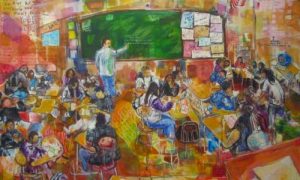Preparing Students for Life – This case study describes how sociocultural and activity theory were applied in the design of a publicly funded, Canadian Language Benchmark (CLB)-based English as a Second Language (ESL) credential program and curriculum for immigrant and international students in postsecondary institutions in British Columbia, Canada.

The ESL Pathways Project was conceived to prepare immigrant students to navigate the multiple pathways in the settlement process from postsecondary education to the workplace, community participation, and citizenship. The in-novation in curriculum design resulted from the systematic reinterpretation of situated cognition and task-based design using activity theory.
Given that both situated and task-based learning share intersecting theoretical lineages with ac-tivity theory, this reinterpretation was more a deepening and improvement than a reconceptualization process. The ensuing units were defined by the real-world activities and contexts of target communities of practice, with relevant instructional topics, tasks, genres, skills, and outcomes presented in a systematic manner to support learners to participate, ultimately, in those target communities.
This process contrasts with traditional ad hoc forms of task-based curriculum design in ESL and EAP (English for Academic Purposes). Four key challenges, profiled herein, motivated the innovative approach to curriculum design presented in this article: (a) the internationalization of higher education, (b) the need to accommodate increasing numbers of linguistically and culturally diverse learners, (c) the need to address contextual needs beyond disciplinary knowledge, and (d) the shift to outcomes- or competency-based instructional design and assessment.
This article has described the application of sociocultural and activity theory, research, recognized standards, and best practices to the process of creating an innovative CLB-, outcomes-, task/activity-, and content-based curriculum that unites the three goals of language learning in community, workplace, and academic study. The approach outlined in this article is recommended for inspiring and guiding the development of innovative curricula that ad-dress real challenges in the sector, namely: to facilitate the integration of inter-national and immigrant learners in higher education, work, and community; to address the disciplinary rigidity that exists in some ESL faculties; and to move to outcomes-based curricula. The ESL Pathways curriculum is offered as an exemplar of an innovative curriculum that continues to evolve to meet these challenges.
After reading “Preparing Students for Life” you can check important issues for ESL teachers on the section PDFs, and visit my YouTube channel.
